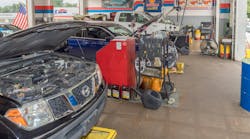Quick lube shops, by their very nature, have unique opportunities to provide value-added services to their customers in an environment where speed, efficiency and value are the hallmarks. And nowhere is this more evident than in under-car service.
Obviously, every customer who lines up at your service bay doors is there for an oil and filter change, and you are expected to check other fluids and systems in the process. This is standard procedure in quick lube shops and can provide needed services to customers while generating add-on sales that boost the bottom line for the shop.
The two keys are: such services must provide value and peace of mind to the customer, and they must also contribute to the viability of the shop.
Standard operating procedure (SOP) in quick lube shops always includes checking the level and condition of various fluids, — brake fluid, power steering fluid and windshield washer fluid — and, typically, wiper blades, various filters — such as cabin air filters — tires and brakes.
But don’t overlook other under-car opportunities in the process. With front- (FWD) and four-wheel drive (4x4) vehicles the new standard, be sure to examine C-V joint boots for tears or thrown-off grease that indicate a cracked or torn boot. It has been reported that as few as eight driving hours with a torn C-V boot can lead to irreparable damage to the joint within. Split boots are quickly and easily installed, and even half shaft replacement can be performed quickly. A quality brake parts cleaner will help clear grit and debris from the area, so you can determine the level of service needed.
Transmission flush and fill is an important service. Sure, you can just drop the trans pan and replace the filter and fluid. But if the pan shows substantial debris or still smells like dinosaurs, it’s best to thoroughly flush the transmission using a dedicated machine to do so. Such machines can connect via the dipstick tube or in-line and can quickly purge harmful contaminants from the transmission. Complete the service with quality ATF, a new filter and a suitable supplement/fortifier, and your customer’s vehicle will be good for many more thousands of miles.
Similarly, power steering systems are usually neglected until a belt or hose breaks, but you owe it to your customer to recommend flushing or fortification, as needed. We and other manufacturers offer power steering flushing systems that quickly and efficiently purge these critical safety-related systems, allowing them to be renewed with fresh fluid and a fortifier to extend the life of the fluid and components even longer.
Speaking of neglected systems, when was the last time your shop serviced a differential? While FWD cars lack a conventional differential, 4x4s typically use conventional-looking differentials for the front and rear axles. And there are still more rear-wheel drive cars on the road than you might think.
Repairing or replacing differentials is a costly and time-consuming task. Gone are the days when you could just pull out axle shafts and load a “pumpkin” out the front of the rear axle housing. Virtually all of today’s differentials require removal of the pinion and rear cover plate for differential repair. This disturbs crush sleeves and gear mesh settings, and requires precision and tedious re-assembly.
You owe it to your customers to, at the very least, drain and replace the differential oil. With torrential rain and flooding so prevalent in recent history, it is likely that many differentials have been in water deep enough for it to enter through the vent on top. In such case, if you suspect water intrusion into the differential, you owe it to your customer to use a dedicated differential cleaner to purge water, gum, varnish and sludge from this drivetrain workhorse. It may well be the only time the vehicle will ever receive this important service and will help preserve it, so it may never need performing again. This once-in-a-vehicle’s-lifetime service should be an easy sell to any motorist who plans to keep their car for a while.
In these cases, as in so many other instances, scientifically-blended chemicals and additives can go a long way toward forestalling expensive repairs.





